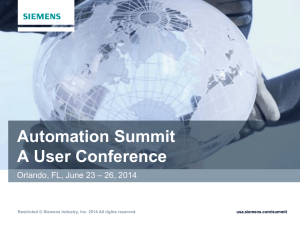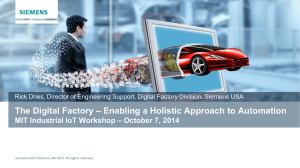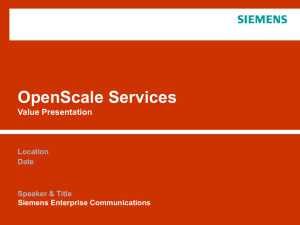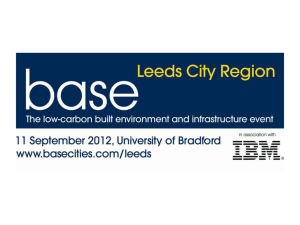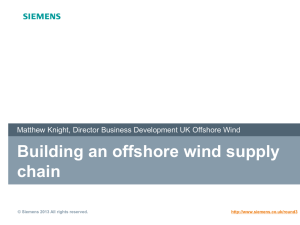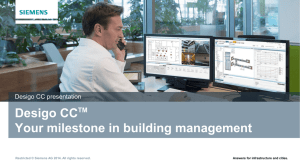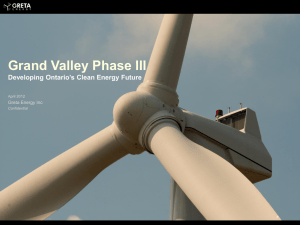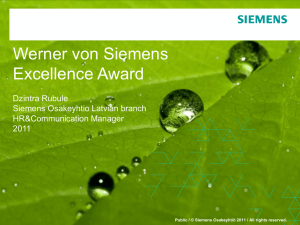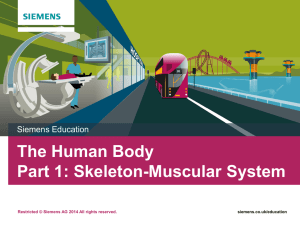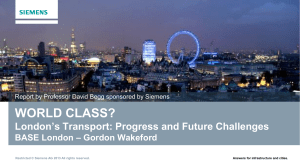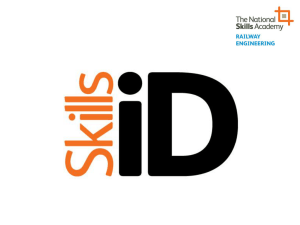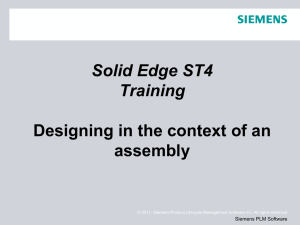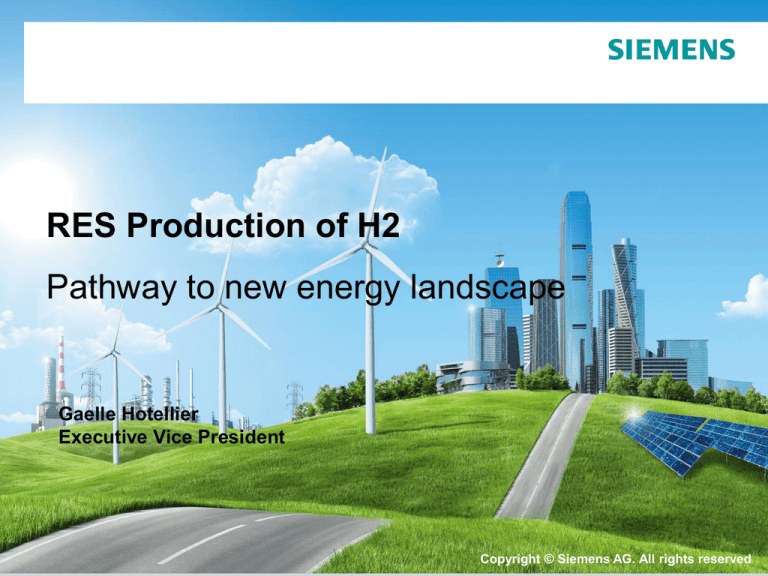
RES Production of H2
Pathway to new energy landscape
Gaelle Hotellier
Executive Vice President
© Siemens AG 2013. All Rights Reserved.
Copyright © Siemens AG. All rights reserved
Big Picture Hydrogen
Conversion of electrical into chemical power
Generation
Conversion In / Out
Utilization
Direct utilization w/o storage
Mobility
(H2-Fuel)
H2
Fuel Cell Car
solar power
O2
H2
+
-
H2-Storage
H2
CH4
Intermittent
generation
wind power
Steady
generation
Energy
(Re-Electrification)
Gaspipeline
„Convergence“
H2O
PEM-Elektrolyzer
*
H2
CH4
Gas-Turbine
injection
H2
Industry
(H2-Utilization)
Grid
CO2
Methanation / CO2
utilization/ others
Industry
fossile
H2 drives the convergence between energy, industry & mobility markets
*partially (in case of cheap power)
© Siemens AG 2013. All Rights Reserved.
Water Electrolysis
Principle
Basics
2H20 2H2 + O2
Key specs
DC current splits water into
hydrogen and oxygen
PEM* technology
O2
H2
production rate is related to
current
electrode
gas-diffusionlayer
9 liters of water yield 1 kg of
hydrogen
approx. 50 kWh electrical
energy generate 1 kg/h
hydrogen
1 kg of hydrogen contain
33,3 kWh energy
bipolar plate
PEM-electrolyte
H2O
* Proton-Exchange-Membrane
purpose: - ion conductor (H+)
- electric isolator
- gas-tight separator
The PEM technology uses a robust polymer membrane as electrolyte
© Siemens AG 2013. All Rights Reserved.
PEM Electrolyzers are technologically promising
compared to alkaline technology
+
Maintenance
No caustic potash solution
No leaching
No precipitation
+
Dynamic
Cycles 0 % .. 300 % without
relevant aging
+
High current density
allows compact
construction
+
+
Operating costs
€
Highest dynamic for lowest
current prices
+
Lifetime
No caustic potash,
less corrosion
Construction
Operability
No inert gas flushing
No protective electrodes
current
No preheating
+
+
Size
Pressure
High System pressures
Low compression costs
Modular, scalable
Industrial standards
© Siemens AG 2013. All Rights Reserved.
PEM Electrolyzers @ Siemens
Leading edge technology for high capacity electrolyzers
Hydrogen: Enabling conversion between electrical and chemical energy
Excess Energy
Renewable Energy
PEM Electrolyzer Technology
Robust polymer membrane as electrolyte
Extremely dynamic and tolerant to
overload even under pressurized
operation
High pressure operation without
efficiency loss
Operation as dynamic load for secondary
and even primary control power
Pure water – no leach
on-off switching without any delay
No N2-purge and preheating necessary
Chemical Energy
Siemens Expertise
PEM electrolyzer development started
1998
Reference list in electrolyzer technology:
- continuous lab operation > 50.000 h
- 10y field operation (prototype)
- 100 bar prototype
- 40y electrode know-how
complete solution in one hand
- heavy duty rectifiers (up to 70.000 A)
- transformers
- control units
- grid connection
- gas turbines
© Siemens AG 2013. All Rights Reserved.
100 - 300 kW PEM Electrolyzer Demonstrator
Under operation
Key statements
Rated power of the system is 100
kW, peak power 300 kW (electrical
stack input)
H2 and O2 are produced at an
output pressure of 50 bar
The container is a „self-sustaining“
system. Power supply as well as
water purification are onboard
The demonstrator was delivered
2012 to RWE in the context of the
BMBF-funded project CO2RRECT*
Siemens Elektrolyzer at the RWE site Niederaußem
*CO2-Reaction using Regenerative
Energies and Catalytic Technologies
First Siemens electrolyzer units under operation at customer sites.
© Siemens AG 2013. All Rights Reserved.
Control power - Additional path for PEM Technology
as it is based a.o. on reaction time
Transmission System operators
(TSOs) are responsible for safe and
reliable network operations in their
respective control area.
To fulfill the task “frequency
stability”, TSOs need balancing
power.
The Control Power call takes place
timely phased and is split between
primary and secondary (or minutes
reserve) regulation.
Control Power can be either positive
or negative (neg. = consumption/
production; pos.= production/
consumption)
2 business case opportunities:
“demand price” (= stand-by) and
“working price” (= release order)
Interesting link:
https://www.regelleistung.net/ip/acti
on/index?language=en
The Primary Control secure the
rebalancing between produced and
consumed power within seconds,
whereat the frequency remains within
the authorized limits.
The objective of the Secondary
Control is to put the frequency back
to its desires value und the power
transfer to the agreed values, and
herewith to have the whole activated
primary regulation available as
reserve again
In addition to the secondary regulation, the
transmission grid operator need Minute
reservel to restore free secondary balancing
power range as well as the balancing of
power deficits not being solved through
secondary regulation only.
© Siemens AG 2013. All Rights Reserved.
PEM Electrolyzers @ Siemens
Operation as Control Power
• Startup time (blackstart) ~ 10 min
• From standby to full load in < 10 sec
• Full dynamic behavior between 0 and 300% electric load
(positive, negative or combined mode control power)
Power in %
normal operation
providing
negative control power
providing
positive control power
300%
negative Regellast:
200 %
200%
100%
positive Regellast:
100 kW
PEM electrolyzers can be operated as efficient dynamic load for secondary
and even primary control power
© Siemens AG 2013. All Rights Reserved.
SILYZER – Electrolyzer Systems from Siemens
Up-scaling Roadmap “SILYZER family”
Roadmap: PEM Electrolyzer Portfolio “SILYZER”
Rated Powernominal
2012
2014
2015
2018
Product line I
0.1 – 0.3 MW
Product line IB *
0.2 - >1 MW
Product line II
1 - >10 MW
Product line III
10 - >100 MW
100 MW
SILYZER 100
SILYZER 100
SILYZER 200
SILYZER 300
10 MW
1 MW
Key take away
Siemens has established
the business unit
“Hydrogen Solutions” to
develop and industrialize
PEM electrolyzer systems.
The Siemens PEMelectrolyzers will be costcompetitive to alkaline
technology.
Modular Systems in the
MW-range will be
available starting 2015,
demonstrators in the subMW-class in 2013.
0,1 MW
© Siemens AG 2013. All Rights Reserved.
I DT LD HY
Industry Sector
Drives Technology Division
Hydrogen Solutions
contact:
Gaelle Hotellier (Executive VP & General Manager)
+49 9131 7-22847
mailto:gaelle.hotellier@siemens.com
© Siemens AG 2012. All Rights Reserved.
Copyright © Siemens AG. All rights reserved

